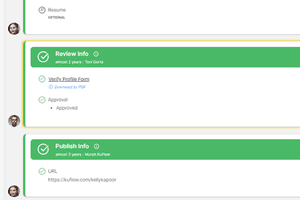Elevate Your Sales Game: Unleashing the Power of Automation
Published 19-12-2023 by KuFlow Team

Credits: Pexels
As the landscape of sales and business processes evolves, the strategic integration of automation becomes a cornerstone for driving efficiency and achieving optimal results.
For directors of sales and sales experts, the paradigm shift toward automated workflows is not just a trend but a necessity.
In this exploration, we delve into the transformative power of business process automation, dissecting its applications in each stage of the sales cycle.
This article aims to empower sales leaders with insights into harnessing technology to streamline operations, enhance customer experiences, and ultimately elevate the success trajectory of their sales teams.
How do we define sales automation?
Sales automation is the process of using software and tools to automate sales processes, including lead generation, email marketing, and sales forecasting.
In other words, we define sales automation as any technology that can replicate human cognitive capability (such as logical reasoning, pattern recognition) and mechanical tasks, thus reducing manual labor in a given sales process.
While multiple technologies are available, there are usually five technologies as core to sales automation efforts:
- machine learning (ML)
- robotic process automation (RPA)
- natural language processing (NLP)
- smart workflows
- virtual agents
Currently, machine learning and robotic process automation are the most popular technologies in sales.
Why we need to automate sales
Sales automation gives sales reps the tools they need to close more deals without sacrificing the quality of human interactions.
According to McKinsey research, there is a high correlation between the time sales reps spend with customers and sales productivity.
On average, high-performing sales reps spend 20 to 25 percent more time with customers than lower-performing reps. Companies that standardize and automate non-customer-facing activities, such as administrative tasks, free up time for activities that directly drive performance, such as opportunity identification, negotiation preparation, and customer interaction
Only 34% of the average salesperson’s time is spent on selling. While the remainder of their time is spent on admin tasks like:
- Data entry
- Attending internal meetings
- Writing emails
- Training
- Scheduling meetings
- Prospecting, finding contact information, and researching leads
- Researching sales tips and reading industry news
Benefits of sales automation
Through an effective sales automation, you can expect the next benefits in your daily operations:
- Increase productivity
- Saves time
- Accelerate your sales
- Keeps sales data consistent
- Better deal management
- Focus on high-quality leads
- Better communication and collaboration
- Task reminders
- Easier scheduling
- Better reporting
Benefits for sales reps
Sales representatives achieve optimal results when they allocate a significant portion of their time to prospecting and cultivating relationships. The sales process automation serves as a valuable support mechanism, alleviating the sales team from the burdens of numerous manual tasks involved in the identification and nurturing of leads.
For example, process automation can help:
- Make more time for prospecting
- Provide a sales funnel visualization
- Automate emails and notifications
- Reduce manual work and data entry
- Eliminate repetitive tasks
- Create consistent workflows
- Build a consistent and structured process
Benefits for sales managers
Sales managers also benefit from automation. For them, gaining a clear view and understanding of the sales process, the sales funnel, and the performance of their team is indispensable in shaping strategic initiatives and achieving established objectives.
For example, automation helps sales managers:
- Define the average sales cycle
- Determine conversion rates
- Track team performance
- Identify bottlenecks
- Spot problems in the sales pipeline
- Manage deadlines
- Automate approvals
- Monitor progress towards sales goals and targets
How to apply automation in sales
Sales strategy and planning
- Market intelligence gathering
- To create a targeted campaign, the marketing team should sort out and validate the company’s target audience demographic or customer data.
- This would involve cleaning, filtering, copying, and pasting large sets of data from the source onto the company’s database.
- RPA bots can be programmed to complete these steps at determined intervals (i.e. every two weeks or so), and by doing so, provide the marketers with a constant flow of high-quality data.
- Customer profiling for churn prevention
- Automated analysis of customer behavior enables timely, personalized interventions, reducing churn risk. Precision and agility ensure enhanced retention and satisfaction.
- Reporting
- Bots can gather data from a business’ different platforms, such as CRMs, ERPs, social media accounts, and data warehouses, to automatically create analysis reports
Lead management
- Collecting leads
- Businesses usually offer an e-book or demo to showcase their products to potential customers in exchange for their email address, personal (name, age, gender), and professional (job title, position) information.
- A bot can automatically capture this information and store it in the database for lead assessment.
- Other examples:
- Instantly send leads from your website forms straight to your email marketing tool
- Automatically add leads from ad campaigns to your CRM
- Send leads who sign up for webinars or events right to your CRM
- Lead enrichment
- Lead enrichment
- Lead enrichment is the process of filling in the gaps in your lead data, like a missing email address, first/last name, or other essential contact information. This can be an incredibly tedious and time-consuming approach to data entry.
- Automated lead enrichment provides sales reps with a complete prospect profile so they can nurture their relationship and move the connection forward.
- Assign and complete lead data
- Sales automation software can analyze the leads in your sales pipeline and assign them to the most skilled reps. It uses various factors like geographic location, experience, and other specific criteria to assign reps to a prospect. This will surely improve your conversion rate.
- A sales automation tool uses static data and insights from your previous prospects to create a target prospect profile. In this manner, it can automate your lead generation process and find you the ideal prospects that best match your services. That means reps can spend less time on prospecting and instead concentrate on actually converting those prospects.
- Scoring leads for lead evaluation and prioritization
- Once the information is gathered, marketing and sales teams can analyze the data to assess the suitability of the leads (i.e. lead scoring).
- An automated system can assess the information of thousands of potential leads by comparing their data to a predetermined set of parameters. For instance, the algorithm can be programmed to dismiss any user’s data if they have left their “occupation” empty.
- Lead enrichment
- Customizing proposals
- Information such as the product to be purchased or payment preferences can be pulled from the CRM to create custom proposals for potential customers.
- Instead of the staff copying and pasting this data from CRM onto a document, RPA bots can be programmed via screen-scraping to automate proposal customization.
- Sales follow-up automation and bot-driven lead engagement
- Manual follow-ups can be time-consuming. Writing follow-up emails every time or pasting the same follow-up emails over and over will only reduce your reps’ productivity. So, what you can do is simply create a few templates and then automate them. That’s scheduling your follow-up emails to ensure that you’re chasing each valuable lead twice or thrice.
- This can be a useful practice for your sales team. With sales automation software, you can always stay in the loop on what your prospects are thinking, in which stage of decision-making they are in, and whether they are even considering your product or service or not. All this information can provide you with greater clarity over your sales strategy.
- Keep lead information up-to-date
- Maintain all the information systems that support the management of your company's sales, through automated mechanisms that avoid time-consuming manual tasks.
- Instantly send lead information from your CRM to your email marketing platform
- Update your lead tracking app information when customers make a payment
- Share lead information from your CRM with your ad tools
- Other examples of lead management
- Automatically reach out to leads after they've made a purchase
- Send meeting reminders (with agendas) to your leads
- Instantly message a lead when they fill out a form
Configuration, pricing and quotation
- Pricing
- Dynamic pricing is a pricing strategy by which firms can marginally change their prices in real-time relative to their competitors, to get a competitive advantage.
- Especially for businesses in competitive markets, such as the hospitality (i.e. hotel room prices) and aviation industry (i.e. airplane ticket prices) where multiple vendors are selling the same products, dynamic pricing can be a profitable strategy.
- Automated algorithms can adapt prices in real-time, ensuring competitiveness and maximizing revenue in evolving markets
- Pricing information from competitors
- Businesses can leverage web scrapers that use RPA to automatically collect pricing information from competitors’ websites and compare it to their own.
- Then, based on predetermined margins, ~5% for instance, the RPA automatically changes the price while a window of opportunity exists. And if price movements are so abnormal that they would require staff oversight and approval for any change, a push notification can be sent accordingly.
- Discount management workflow
- Within the automated sales landscape, a discount management workflow is instrumental. Automation streamlines the application and tracking of discounts, ensuring precision in offers and contributing to a seamless and efficient sales process
Order management
- Chatbots
- Chatbots enable companies to re-engage prospective customers who are stuck in the purchasing funnel, thus creating new opportunities without any extra human effort. The bot independently selects customers, contacts them through text messages or email, uses natural-language processing to understand the context of their response, and answers accordingly to drive conversion. This solution can increase sales reps’ selling time, while increasing deal-flow transparency and conversion
- RFP generation
- Whether it’s through a website or an email, RPA bots can be programmed to collect all order data from various sales channels and input them into the order management software
- SLA Tracking
- Automated workflows streamline monitoring, alerting teams to potential breaches, and optimizing overall service delivery efficiency
- Workflows para receivables and payables
- If payment is to be received sometime after the sale is made, or if it is deferred for any reason, an automatic email with a payment gateway can be sent to the customer, politely reminding them of their obligation and allowing them to instantly settle their debts.
- Smart workflows
- Customer billing
- The data (customer’s name, address, delivery method, payment method) from various sales channels is recorded and printed on the invoice automatically.
- Inventory management
- Instead of the sales representative contacting the warehouse to check for availability of the ordered goods, automated systems can cross-check it with the inventory CRM instantly.
- Customer billing
Postsales activities
- Cross/up-selling recommendations
- Automation empowers businesses with cross/up-selling recommendations, leveraging customer data for personalized suggestions. Streamlining the sales process, it enhances customer engagement and maximizes revenue opportunities in every interaction.
- Journey optimization
- Robotic process automation and virtual agents can be used to reinvent the customer journey and create a seamless online process for ordering, tracking, and query management.
- Product Activation
- Bots can prepare license certificates for new customers and create emails that provide customers with license keys to activate their purchases. Bots verify that an order is valid and update internal functions, such as finance and legal, about the activation. The bot can save sales operations teams hundreds of hours per year and enable customers to activate their products much faster than before.
- Contract autorenewal and renewal notices
- RPA bots can be programmed to collect data from the customer’s list and automatically reach out to customers a week before their subscription ends.
- Transactional email technology, for example, is a tool designed to create personalized emails to send customers for membership renewal notices.
- For customer feedback, RPA and NLP-based solutions can streamline the collection and categorization of feedback for quicker resolutions
Key Takeaways
Work smarter not harder
Companies should think of automation not as a replacement for their sales force, but as a powerful tool that complements salespeople, rids them of low-value-added tasks, and boosts their efficiency.
The more standardized, the better
To capture the benefits of sales automation, sales leaders must first recognize that, while anyone can deploy sales automation and capture its benefits, those with standardized sales processes in place and colocated/centralized sales support functions usually capture bigger benefits from automation and see impact faster than their peers. This is because their costs for data integration, technological deployment, and change management are lower.
Similarly, an extensible customer relationship management (CRM) system and a consolidated IT stack usually help enhance the scalability of automation solutions. The leaner, more simplified, and more digitized the internal sales processes, the faster basic automation (RPA) can be deployed and more advanced solutions, such as machine learning and cognitive agents, can be implemented.
Change management is key
For automation programs to be effective, salespeople need to work differently. Change management involves:
- training reps and managers (best-in-class companies train sales reps both in workshops and in the field)
- tracking impact via key performance indicators (KPIs), time saved, or the monetary value of automated customer conversion
- putting in place appropriate incentives
- communicating with all relevant stakeholders (a periodic communication cadence should be established to engage and inform sales reps)
As you embark on the journey to revolutionize your sales, remember that the true potential of automation lies in its application. KuFlow stands as a catalyst for this transformation. Elevate your sales game, streamline operations, and maximize results. Take the next step toward a future of efficient, data-driven sales. Contact us today and let's embark on this journey of automation together.
Visit us in KuFlow to start your automation journey.





